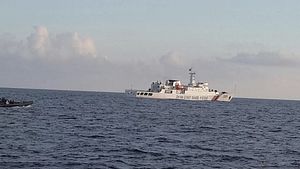At a birthday party for a seasoned journalist in Bali more than four years ago, diplomats from foreign embassies arrived bearing gifts that only a reporter can appreciate. They collared me and began to tell a tale, conditional upon the fact that the sources were to remain off the record.
The Chinese had arrived in Jakarta in the form of a senior military delegation a month earlier and toured the archipelago as guests, but they were stunned when snubbed by Indonesians at every turn. Even hotel staff ignored their routine requests.
Brash to the point of barking orders, the Chinese generals had upset the locals who responded in kind, and they went home humiliated. This formed a distant backdrop for the latest dispute in the South China Sea, with Indonesia renaming its recognized sovereign waters as the North Natuna Sea.
The renaming was an important decision and follows examples set in Hanoi where the South China Sea is known as the East Sea, and in Manila where the disputed waterway has been renamed the West Philippine Sea.
In Bali, that evening, diplomats were also focused on naming rights.
Indonesia had adopted a low-profile, behind-the-scenes resistance plan to China’s maritime expansion into recognized international and disputed waters through Beijing’s nine-dash line, but it was poorly laid out. Jakarta wanted some clarity and the visiting generals were expected to provide that.
Concerns were also focused on the resource-rich Natuna Islands – long recognized by them as clearly being Indonesian.
China’s so-called nine-dash line encircles almost the entire sea – often encroaching upon the 200 nautical-mile exclusive economic eones (EEZs) of neighboring countries – and it was terribly vague in its southern part.
That’s hardly surprising, said the diplomats, given the fact that Chinese cartographers had historically not paid as much sustained attention to the waterway as Beijing officially claims. It was not really until 2009, when Beijing formally attached a map of the line in a submission to the United Nations, that it grabbed world attention.
Indonesian generals, confronted by their Chinese peers on home soil, had one question, which had long dogged them: Does the most southern tip of the nine-dash line fall north or south of the Natuna Islands? Their response, said the diplomats that evening, was: “South.”
The Indonesians continued to be troubled by this, and their silence became deafening. At that point, a more assertive approach, including potentially renaming the area of the South China Sea under Jakarta’s stewardship, was also considered.
But the politicians, under then-President Susilo Bambang Yudhoyono, remained coy. With elections looming the following year, a confrontation with China over its maritime advance south of the Natunas was unwanted, and the diplomatic spat was politely pushed to one side.
It was an unwritten policy that incoming President Joko Widodo was initially happy to follow.
But increasing arrivals of Chinese vessels in Indonesian waters made that stance and management of the Natunas impossible.
Tensions simmered until late 2015 when Hong Lei, China’s Foreign Ministry spokesman, surprised his neighbors with Beijing’s first-ever public statement clarifying its position on the Natunas, which stated: “The Indonesian side has no territorial claim to China’s [Spratly Islands]. The Chinese side has no objection to Indonesia sovereignty over the Natuna Islands.”
Delivered as if it were an olive branch, the statement was but a half-baked effort, especially when viewed within the broader context of the type of bilateral bullying Beijing had been engaged in with other claimants and Southeast Asian states more generally.
Indonesia, like most states in the region, does not recognize China’s nine-dash line, where more than half the world’s shipping tonnage traverses international shipping lanes, reportedly ferrying around $5 trillion worth of goods a year.
Nor has Indonesia any interest in relinquishing its claims in the region in return for Chinese recognition of the Natunas, which according to diplomats in Bali already belonged to Indonesia anyway.
An international tribunal has found that Beijing’s nine-dash territorial claims have no legal basis, which is a further boost for Jakarta in its effort to raise concerns in this regard.
Jokowi has continued to invested heavily in the Natunas, and he has even toured the area himself. This name change finally signals a tougher approach to border security. And despite the insecurities of the pro-China camp on this issue, his country’s territorial boundaries and the North Natuna Sea might actually help in clarifying the many maritime discrepancies in the region.
The renamed sea is also defined by Indonesia’s EEZ and does not stretch into international waters. That should leave the captains of Chinese civilian and military vessels in no doubt about whose waters they are actually sailing within, legally speaking.

































